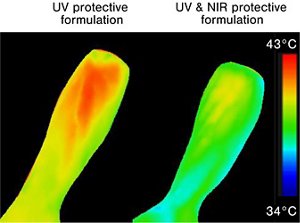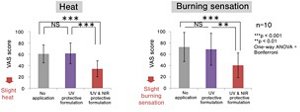New Technology for Protection from Exposure to Near-infrared Component of Sunlight – Control of Uncomfortable Burning Sensation Associated with Skin Surface Temperature Elevation
This is an English translation of a news release in Japanese on November 25.
The Skin Care Research Laboratory and Processing Development Research Laboratory of Kao Corporation (Michitaka Sawada, President) have developed a protection technology that provides control of the uncomfortable skin surface temperature increase and heat sensation caused by sun exposure. This technology consists of thin titanium dioxide flakes that block the near-infrared (NIR) rays in sunlight in a highly efficiently manner.
The findings of this study were presented at the 85th meeting of the Society of Cosmetic Chemists of Japan (SCCJ) on November 27, 2019, in Tokyo, and there won the best presentation award.*1
Kao is dedicated to providing sunlight protection care products by making use of important findings from our research efforts.
-
* 1 This information regarding the award was added to the release on December 18, 2019.

Comparison of skin surface temperature at 5 minutes after artificial sunlight exposure.
Background
Solar light can be roughly categorized based on wavelength, such as ultraviolet, visible, and near-infrared rays (Fig. 1). When human skin is exposed to the sun's rays, inflammatory response and photo-aging caused by UV light are well-known effects. It has also been reported that NIR can induce oxidative stress, wrinkles, and skin sagging, as well as increased skin surface temperature.

Fig. 1. Solar spectrum
According to a survey conducted by Kao, 49% of the respondents experienced discomfort such as 'tingling' and 'burning' of skin exposed to strong sunlight that could not be prevented by wearing sunscreen.*2 The researchers focused attention on the NIR component of sunlight as a cause of these problems and their experimental results confirmed elevation of skin surface temperature by 5-6˚C within approximately 5 minutes of exposure to direct sun rays. Furthermore, that temperature rose to more than 40˚C when skin was exposed to a hot environment with an outside air temperature greater than 28˚C. When skin surface temperature increases to about 42˚C, sensory receptors become activated, causing pain sensation. The skin burning sensation noted when exposed to sunlight or a hot environment is considered to be induced by surface temperature increase.
In an effort to provide strong protection against sun and heat exposure, experiments were performed to produce an effective NIR protection technology.
-
* 2 Kao Corporation investigation performed in 2019 (1500 male and female subjects, aged 20-50 years).
Methods and Results
Kao has tested a variety of materials for blocking NIR by light scattering, though none were found satisfactory for control of skin surface temperature. Accordingly, by focusing attention on principle factors related to light wave interference, a new material capable of selective blocking of the NIR wavelength was investigated. The findings showed that a high NIR protection capability could be attained by controlling the thickness of the thin titanium dioxide flakes, a cosmetic raw material.
For the experiments, different sunscreen formulations were applied to subject forearms, including an NIR protective material combined with UV protection formulation (UV & NIR protective formulation) and a conventional sunscreen formulation (UV protective formulation). Following exposure to artificial sunlight, changes in skin surface temperature were determined.
The average skin temperature of forearms without sunscreen application (control group) was elevated by 6.5˚C after 5 minutes of exposure, while that of forearms with the UV protective formulation (conventional sunscreen formulation application) was also increased in a similar manner. In contrast, the average skin temperature increase in forearms with the UV & NIR protective formulation (new combined sunscreen formulation application) was 5.5˚C, a temperature elevation lower by an average of -1˚C and maximum of -1.6˚C (Fig. 2).

Fig. 2. Changes in skin surface temperature
caused by exposure to artificial sunlight.
Subjective evaluations of heat and burning sensation at 5 minutes after exposure were also performed. Those findings showed that visual analog scale (VAS) scores were significantly lower in the group that received application of the novel UV & NIR protective formulation as compared to both the control group without application and the group applied with the conventional sunscreen formulation (Fig. 3).

Fig. 3. Subjective evaluations of heat and burning sensation.
Conclusion
Successful development of a new protective technology that blocks NIR in a highly efficient manner for control of skin surface temperature elevation caused by sunlight was attained by Kao researchers. The study results confirmed that this new technology reduces both skin surface temperature increase and the sensation of heat caused by exposure to sunlight, which were not prevented by a conventional formulation containing only a UV protective agent.
The findings obtained will be implemented for further development of sunlight protective care technology.
About Kao
Kao creates high-value-added products that enrich the lives of consumers around the world. Through its portfolio of over 20 leading brands such as Attack, Bioré, Goldwell, Jergens, John Frieda, Kanebo, Laurier, Merries and Molton Brown, Kao is part of the everyday lives of people in Asia, Oceania, North America and Europe. Combined with its chemical division, which contributes to a wide range of industries, Kao generates about 1,500 billion yen in annual sales. Kao employs about 33,000 people worldwide and has 130 years of history in innovation. Please visit the Kao Group website for updated information.
Media inquiries should be directed to:
Corporate Communications
Kao Corporation
